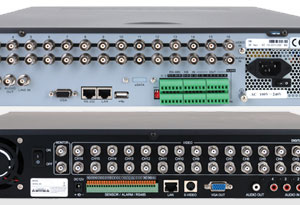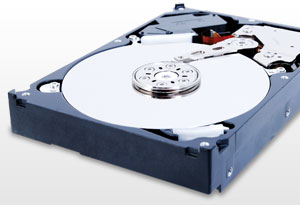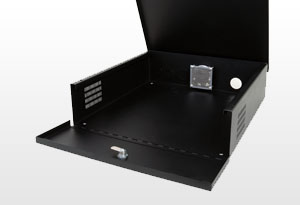Choosing the RIght Recording Device

First, ask yourself the question, "What are my key needs?" To select the best video recorder for your needs, you must consider the following requirements:

Lifestyle — Do you spend much time at your property? Do you travel? Answers to these questions will determine whether or not you need a DVR with a large hard drive. This gives you plenty of recording time so that you can view events that happened weeks earlier.
Remote monitoring — All of our security DVRs come ready to connect to the internet. All you need is a high speed DSL or Cable connection at your property.
Notification — We highly recommend that a DVR for busy lifestyles be equipped with email or SMS notification. DVRs offering these features can be programmed to alert you when suspicious activity occurs. Some DVRs will even send you still shots or video clips of recent activities.
Record times — When it comes to recording capacity, the critical question you need ask yourself is, "If a crime does occur, what is the longest amount of time that passes until I'm notified?" If you're absolutely certain that you be notified within just a few days – even if you're out of town — then almost any sized hard drive will work.
Tip: Don't let conversations go unheard. Most DVRs have audio recording capabilities, allowing you to add a high quality mic or leverage the microphones built-into your cameras to capture a second dimension of the crime.
However, for fraudulent claims against your business, you may need to review video evidence up to several weeks after an incident. To protect yourself, the sure bet is to get the largest size hard drive possible.
The benefits of H.264 compression technology
All of our DVRs come equipped with H.264 video compression technology, which offers the following advantages over other popular compression methods:
- Increased storage capacity — H.264 will give 42% longer recording time than the popular MPEG-4 compression method
- Enhanced image quality — H.264 delivers cleaner, crisper images at high frame rates
- Faster video transmission — H.264 produces smaller file sizes, resulting in faster transmission of your data when remote monitoring your cameras across the world-wide-web.
Compare Models
Tip: Turn your Security DVR into a full time security guard … use alarm inputs, trigger outputs, and motion detection to alert you should something occur.
Selecting the right DVR for you comes down to 3 basic considerations, in the following order:
Triplex vs. Pentaplex Operation
Triplex and Pentaplex are terms indicating how many functions the DVR can perform simultaneously. Both offer simultaneous recording, playback, and remote viewing, while Pentaplex also allows for live viewing and backup at the same time.

For many applications, Triplex operation is sufficient, but a DVR offering Pentaplex operation is recommended if you anticipate that more than one person will be using the DVR simultaneously, such as a store owner and store manager.
Number of Channels
Most DVRs offer inputs for 4, 8, and 16 cameras. Your site survey should provide you with the number of cameras required for sufficient coverage of your property.
Remember, we highly recommend that you purchase a DVR that can record more cameras than you'll think you need.
Many of our customers who opt for the minimum number of cameras quickly see the payback of their security system purchase and want to add more. A small investment in a larger recorder today will save you time and money in the future.
Tip: Be prepared to off load your video (and audio). Keep DVD's and CD's available for quick archiving and sharing of evidence with law enforcement.
Size of Hard Drive
There are five things that effect how long your DVR can record: the hard drive size, number of cameras recording, compression method, video quality, and frame rate.
Based on your site assessment and DVR selection, the number of cameras and compression method are fixed. You can manually adjust your DVR for recorded video quality (or resolution) and frame rate during installation.

Hard Drives
We highly recommend that you purchase a pre-installed hard drive vs. installing one yourself.
There are many benefits to this: The professional grade hard drives that Supercircuits offers are specifically designed for the continuous recording needs of security applications, delivering the ultimate in performance and reliability.
We will format your hard drive, and test all critical functions of the DVR after your hard drive has been installed, FREE of charge.
Unfortunately, installing your own hard drive will void the warranty of your DVR, as this could compromise the integrity of your system. Learn more about the benefits of security optimized hard drives.
Networking your DVR
Tip: Hard drives are typically the first component of your system that may fail – so you don't want to skimp out here.
Every DVR includes a simple, step-by-step guide to networking your device so that you can view video from anywhere in the world via the internet.
If you need additional help, our tech support agents are a mouse click away. They can log into your system remotely and do it for you — typically in under 5 minutes.
To compare video recorded at different frame rates – check out our online frame rate comparison tool.
Accessories
Keep your DVR secure!

Cunning criminals, well aware that their actions are being monitored, will do most anything to destroy or prevent you from capturing evidence. At a minimum, your DVR should be tucked away to where it's out of sight and out of mind.
For additional protection, we offer steel lock boxes for your DVR that will not only keep it secure — but the onboard fan will keep it cool.
Never lose power!
More determined criminals will often cut off power to your property before gaining entrance, or take advantage of power outages due to natural disasters.
To make sure your DVR continues to record in these situations, a UPS (Uninterruptible Power Supply) is an absolute must. On average, a small UPS will deliver an extra 30 to 60 minutes of power to both your cameras and DVR.
Looking for more DVR tips and hints? Read 10 tips to get the most from your video security DVR.
« Step 1: Perform a Site AssessmentStep 3: Select the Perfect Cameras »



